

| Prince Albert, the consort of Queen Victoria, died in 1861 to be mourned by his Queen thereafter for decades. This monument, like a medieval shrine or reliquary, pays tribute to his interests and achievements. The shrine proper is 175 feet high with a Gothic-revival spire decorated with angels. A gilded bronze statue of Prince Albert, more than 14 feet high, is seated within the enclosure. The base of the pedestal for the spire has a frieze with 178 portrait-like sculptures in very high relief--these being celebrated artists, architects, sculptors, poets, musicians, painters, and mathematicians from antiquity to the present. (No women made the cut, however.) The four corners of the pedestal have allegorical bronze sculptural groupings representing Commerce, Engineering, Manufacture, and Agriculture. Below the stairways on each corner below the platform are marble allegorical groups representing the four continents: Europe, Africe, America, and Asia. (See below.) | ||
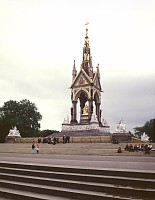
|
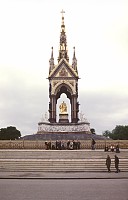
|
Distant viewOriginally the sculptor chosen to design the statue of Prince Albert was Carlo Marochetti, a favorite of Queen Victoria. He worked on several designs but died before any could be executed. So John Henry Foley RA was then selected and is credited with the design, even though he too died before the cast parts were assembled. |
| Symbolic statues of Geometry, Astronomy, Chemistry, and Medicine indicate Prince Albert's interests in science, as does the book his statue holds--the catalogue to the Great Exhibition of 1851, of which he was a chief sponsor. The frieze below indicates his interests in the arts. | 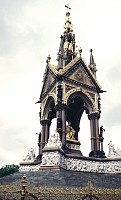
|
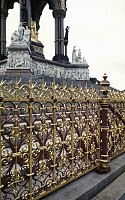
|

|

|
Africa--front and backThis is one of the four marble allegorical groupings representing continents (as well as colonial ambitions). A woman in a cobra crown on the front and a replica of the sphinx on the back represent Egypt. (carved by William Theed the Younger) |
America--two viewsA buffalo, a cowboy, an Indian and other figures represent America. (carved by John Bell) |
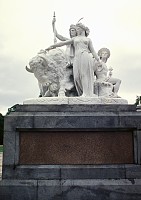
|
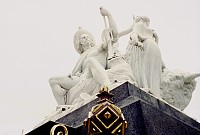
|

|
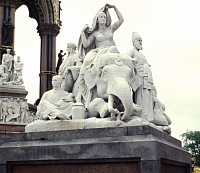
|
Asia(carved by John Henry Foley RA) |
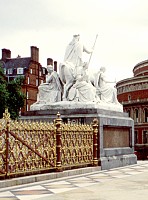
|
Europe--from the rear, with the Royal Albert Hall across the streetCrowned figures representing European monarchs and one equestrian statue comprise this grouping. (carved by Patrick Macdowell) |
|
 Click here to return to index of art historical sites.
Click here to return to index of art historical sites.
 Click here to return to index of artists and architects.
Click here to return to index of artists and architects.
 Click here to return to chronological index.
Click here to return to chronological index.
 Click here to see the home page of Bluffton University.
Click here to see the home page of Bluffton University.
